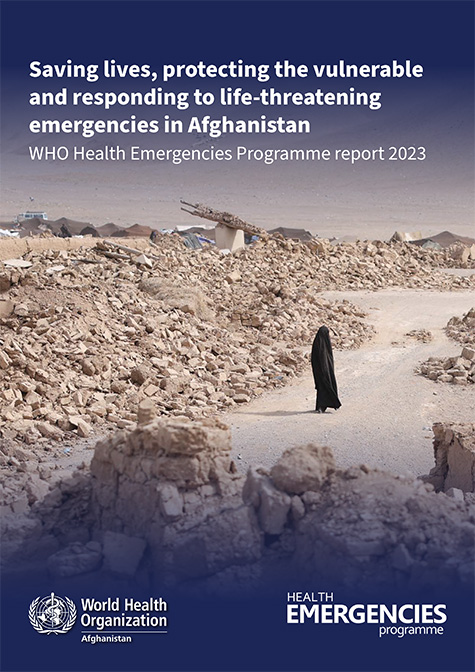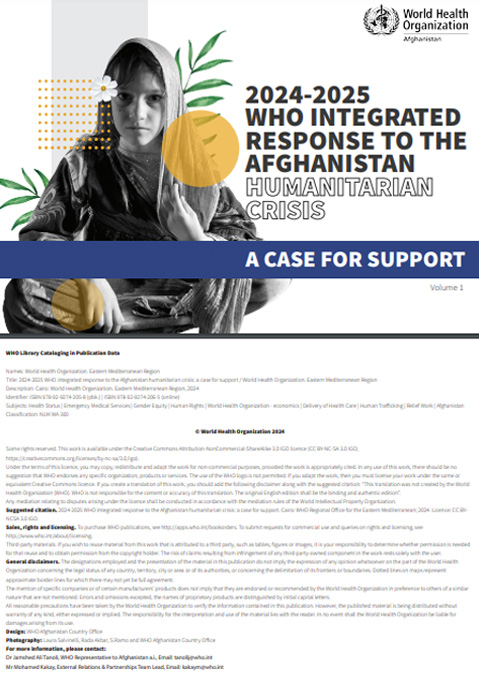Situation updates
Afghanistan suffers from one of the world’s longest protracted complex emergencies due to conflict, natural disasters and mass population movements. In 2018, drought affected two-thirds of Afghanistan, leaving 3.6 million people in need of urgent humanitarian assistance. In addition, increasing conflict in different regions resulted in higher numbers of internally displaced people and trauma cases (figure 1). Nearly 800,000 displaced people have returned from Pakistan and Iran and the number is expected to increase in the coming year. Around 1.9 million people are now in need of humanitarian health services and additional emergency service support. In 2018, trauma cases increased by 24% compared to the same time last year.
In 2018, WHO recorded 85 attacks on healthcare in Afghanistan. Healthcare services were directly targeted in many of these incidences. Afghanistan currently ranks third in term of the severity of attacks on healthcare.
Achievements
WHO EHA
§ Enhanced leadership and institutional capacities, including the development of National Disaster Management Plan and the National Emergency Response Plan for Health, built up national and regional Control and Command Centres (CCC), Information Management System (IMS) and Emergency Preparedness and Response (EPR) Committees at all levels.
§ Scaled up trauma care service in high-risk areas, including supporting 47 hospitals with trauma care capacities through mass casualty management (MCM) plan development, space arrangement, equipment, capacity building and the upgrading of 15 regional and provincial hospitals for improved blood transfusion services.
§ Trained a total of 2,547 medical staff and community health workers (CHWs) on advanced and basic life support (ALS and BLS), triage, ambulance services, safe blood transfusions, mental health and health risk assessment.
§ Provided life-saving medicines and supplies to over 2 million people affected by conflict and natural disasters, including 74 Italian Emergency Trauma Kits, 512 basic Interagency Emergency Health Kits and 85 supplementary IEHK, 446 Acute Respiratory Infection (ARI) kits,50 diarrhoea kits and loose medicines.
Health Cluster
By September 2018, WHO and Health Cluster implementing partners reached 2,017,922 beneficiaries (of whom 1,217,837 were women and girls).
§ Provided emergency health services to more than 85,000 men, women, boys and girls in Herat, Badghis and Ghor in response to the immediate needs resulting from drought at displacement sites and areas of origin.
§ Expanded trauma care service to 18 provinces with First Aid Trauma Posts and Trauma Care Units.
§ Provided emergency health services at all border crossings for returnees from Pakistan and Iran. In 2018, more than 600,000 consultations were provided to returnees.
§ Responsible for reporting attacks on health facilities and healthcare workers as well as related advocacy messages.
Leadership and institutional capacities enhanced, including development of National Disaster Management Plan and National Emergency Response Plan for Health. These included Health Cluster coordination, national and regional Control and Command Centers (CCC) and Emergency Preparedness and Response (EPR) Committees at all levels.
Enhancement of trauma care service in high risk areas, including upscaling of 41 hospitals with trauma care service (TCS) capacities through mass casualty management (MCM) plans development, space arrangement, equipping and capacity building and upgrading of 11 regional and provincial hospitals for improved blood transfusion services.
The data collection for the National Health Emergency Risk Assessment is completed in 266 districts of 34 provinces.
A total of 1,928 medical staff and community health workers (CHWs) were trained in 2017 on advanced and basic life support (ALS and BLS), triage, ambulance services, safe blood transfusions, mental health and health risk assessment.
In the first six months of 2018, WHO Health Emergencies Programme provided life-saving medicines and supplies to over 1,4 million people affected by conflict and natural disasters through stockpiling and distribution of emergency health kits and medicines.
Programme risks and challenges
§ Ongoing conflict results in the movement of more than 1 million people, increasing the need for humanitarian health services.
§ Ongoing food insecurity continues to exacerbate needs for health provision for populations on the move and around the country.
§ Funding pledges are unpredictable due to extended emergencies in the region, reducing the response capacity.
§ Insecurity and limited accessibility to emergency locations in high-risk provinces and damage to hospitals hamper the effort to provide essential emergency health services, capacity building and monitoring activities in conflict-affected areas.
Way forward
-
§ Establish standardized needs assessment methodology to improve the monitoring and reporting of WHO and partner projects.
§ Institutionalize emergency risk analysis and response at all levels (villages, district and provincial).
§ Strengthen MoPH capacity to coordinate and respond to protracted and acute health emergencies.
§ Improve coordination with development partners to ensure sustainable and durable solution to humanitarian crises.
Related links
WHO Emergency and Humanitarian Action monthly updates
WHO Afghanistan Health Cluster
National All-Hazard Emergency Response Plan for Health (NERPH)













